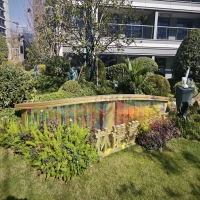Welcome to the website for landscape facilities products and knowledge.
What are the best ways to design landscape tables for use in xeriscapes?
Designing landscape tables for xeriscapes requires a thoughtful approach to ensure functionality, sustainability, and aesthetic harmony with arid environments. Here are the best ways to achieve this:
1. Choose Drought-Resistant Materials: Opt for materials like reclaimed wood, metal, or stone that withstand harsh conditions and require minimal maintenance. Avoid materials prone to warping or fading in intense sunlight.
2. Incorporate Native Plants: Integrate tables with built-in planters for native, drought-tolerant species like succulents or agave. This enhances the table’s visual appeal while supporting local ecosystems.
3. Prioritize Water-Wise Design: Design tables with permeable surfaces or gaps to allow rainwater to seep through, reducing runoff and supporting groundwater recharge.
4. Keep It Minimalist: Embrace clean lines and simple structures to complement the xeriscape’s natural beauty. Avoid overly ornate designs that may clash with the rugged landscape.
5. Use Earthy, Neutral Colors: Select hues that blend with the desert palette—think terracotta, sandstone, or muted greens—to create a cohesive look.
6. Ensure Durability: Xeriscapes often experience temperature extremes. Use weather-resistant finishes and sturdy construction to prolong the table’s lifespan.
By focusing on these principles, your landscape tables will not only thrive in xeriscapes but also enhance their sustainability and visual appeal.
Related search:

Recommendation
Metal and acrylic color-changing combined curtain wall for large-scale public landscape facilities